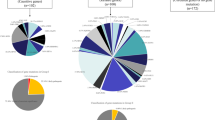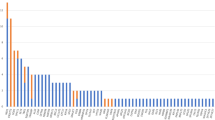Abstract
Objective
The aim of our study was to investigate the genetic characteristics in patients with familial or young-onset amyotrophic lateral sclerosis (ALS) in a Chinese center.
Methods
Patients with familial or young-onset (age of onset < 45 years old) ALS were reviewed. The clinical data was collected. Whole-exome sequencing was performed to identify the disease-associated variants. Single-nucleotide variants and small insertions/deletions were further predicted with silico tools and compared to the Single Nucleotide Polymorphism Database, Exome Aggregation Consortium, and the 1000 Genomes Project. The evolutionary conservations were estimated, and the structures of proteins were constructed by Swiss-Model server. Immunohistochemistry was used to confirm the misfolded SOD1 protein.
Results
Three familial ALS and 5 young-onset ALS were enrolled. Genetic analysis identified related variants of SOD1 (4/6, 66.7%), FUS (1/6, 16.7%), and NEK1 (1/6, 16.7%) in 6 patients. Three of them were familial probands (3/3, 100%), and the others were sporadic young-onset patients (3/5, 60%). NEK1 c.290G > A mutation (NM_012224.2 exon4) in a patient with familial ALS and SOD1 c.362A > G mutation (NM_000454 exon5) in a young-onset ALS patient were novel. The novel mutations were predicted to be deleterious, affected evolutionarily highly conserved amino acid residue and the formation of hydrogen bonds between the mutated site and its surrounding amino acid residues. Misfolded SOD1 protein was identified in patient with SOD1 c.362A > G mutation.
Conclusions
Two novel mutations were detected in our patients. Patients with familial or young-onset ALS often carried related gene mutations, and genetic sequencing should be thus routinely performed.





Similar content being viewed by others
Change history
22 January 2022
A Correction to this paper has been published: https://doi.org/10.1007/s10072-022-05911-5
References
van Es M et al (2017) Amyotrophic lateral sclerosis. Lancet 390(10107):2084–2098
Brown R, Al-Chalabi AJTNEjom (2017) Amyotrophic lateral sclerosis. N Engl J Med 377(2):162–172
Renton A, Chiò A, Traynor BJ (2014) State of play in amyotrophic lateral sclerosis genetics. Nat Neurosci 17(1):17–23
Riva N et al (2016) Recent advances in amyotrophic lateral sclerosis. J Neurol 263(6):1241–54
Chia R, Chiò A, Traynor BJTLN (2018) Novel genes associated with amyotrophic lateral sclerosis: diagnostic and clinical implications. Lancet Neurol 17(1):94–102
Cirulli E et al (2015) Exome sequencing in amyotrophic lateral sclerosis identifies risk genes and pathways. Science 347(6229):1436–41
Kiernan M et al (2011) Amyotrophic lateral sclerosis. Lancet 377(9769):942–55
Leblond C et al (2016) De novo FUS P525L mutation in juvenile amyotrophic lateral sclerosis with dysphonia and diplopia. Neurol Genet 2(2):e63
Simpson C, Al-Chalabi A (2006) Amyotrophic lateral sclerosis as a complex genetic disease. Biochim Biophys Acta 1762(11–12):973–85
Al-Chalabi A et al (2010) An estimate of amyotrophic lateral sclerosis heritability using twin data. J Neurol Neurosurg Psychiatry 81(12):1324–1326
Abel O et al (2012) ALSoD: A user-friendly online bioinformatics tool for amyotrophic lateral sclerosis genetics. Hum Mutat 33(9):1345–51
Chiò A et al (2012) ALS/FTD phenotype in two Sardinian families carrying both C9ORF72 and TARDBP mutations. J Neurol Neurosurg Psychiatry 83(7):730–3
van Blitterswijk M et al (2012) Evidence for an oligogenic basis of amyotrophic lateral sclerosis. Hum Mol Genet 21(17):3776–84
Luigetti M et al (2011) SOD1 G93D sporadic amyotrophic lateral sclerosis (SALS) patient with rapid progression and concomitant novel ANG variant. Neurobiol Aging 32(10):1924.e15–8
Turner M et al (2012) Young-onset amyotrophic lateral sclerosis: historical and other observations. Brain 135(Pt 9):2883–91
Brooks B et al (2000) El Escorial revisited: revised criteria for the diagnosis of amyotrophic lateral sclerosis. Amyotroph Lateral Scler Other Motor Neuron Disord 5:293–9
de Carvalho M et al (2008) Electrodiagnostic criteria for diagnosis of ALS. Clin Neurophysiol 119(3):497–503
Lattante S et al (2012) Contribution of major amyotrophic lateral sclerosis genes to the etiology of sporadic disease. Neurology 79(1):66–72
Sabatelli M et al (2011) Uncovering amyotrophic lateral sclerosis phenotypes: clinical features and long-term follow-up of upper motor neuron-dominant ALS. Amyotroph Lateral Scler 12(4):278–282
Nguyen H, Van Broeckhoven C, van der Zee J (2018) ALS genes in the genomic era and their implications for FTD. Trends Genet 34(6):404–423
Liu Z et al (2019) Genetic spectrum and variability in Chinese patients with amyotrophic lateral sclerosis. Aging Dis 10(6):1199–1206
Liu Q et al (2016) Mutation spectrum of Chinese patients with familial and sporadic amyotrophic lateral sclerosis. J Neurol Neurosurg Psychiatry 87(11):1272–1274
Tsai C et al (2011) FUS, TARDBP, and SOD1 mutations in a Taiwanese cohort with familial ALS. Neurobiol Aging 32(3):553.e13–21
Zou Z et al (2016) The distinctive genetic architecture of ALS in mainland China. J Neurol Neurosurg Psychiatry 87(8):906–7
Hou L et al (2016) Screening of SOD1, FUS and TARDBP genes in patients with amyotrophic lateral sclerosis in central-southern China. Sci Rep 6:32478
Millecamps S et al (2010) SOD1, ANG, VAPB, TARDBP, and FUS mutations in familial amyotrophic lateral sclerosis: genotype-phenotype correlations. J Med Genet 47(8):554–60
Deng J et al (2019) Novel and recurrent mutations in a cohort of Chinese patients with young-onset amyotrophic lateral sclerosis. Front Neurosci 13:1289
Mathis S et al (2019) Genetics of amyotrophic lateral sclerosis: A review. J Neurol Sci 399:217–226
Sabatelli M, Conte A, Zollino M (2013) Clinical and genetic heterogeneity of amyotrophic lateral sclerosis. Clin Genet 83(5):408–16
Yamashita S, Ando Y (2015) Genotype-phenotype relationship in hereditary amyotrophic lateral sclerosis. Transl Neurodegener 4:13
Liu ZJ et al (2017) The investigation of genetic and clinical features in Chinese patients with juvenile amyotrophic lateral sclerosis. Clin Genet 92(3):267–273
Lin HX et al (2019) Identification and functional analysis of novel mutations in the SOD1 gene in Chinese patients with amyotrophic lateral sclerosis. Amyotroph Lateral Scler Frontotemporal Degener 20(3–4):222–228
Brown JA et al (2012) SOD1, ANG, TARDBP and FUS mutations in amyotrophic lateral sclerosis: a United States clinical testing lab experience. Amyotroph Lateral Scler 13(2):217–222
Zelko IN, Mariani TJ, Folz RJ (2002) Superoxide dismutase multigene family: a comparison of the CuZn-SOD (SOD1), Mn-SOD (SOD2), and EC-SOD (SOD3) gene structures, evolution, and expression. Free Radic Biol Med 33(3):337–49
McAlary L, Aquilina JA, Yerbury JJ (2016) Susceptibility of mutant SOD1 to form a destabilized monomer predicts cellular aggregation and toxicity but not in vitro aggregation propensity. Front Neurosci 10:499
Graffmo KS et al (2013) Expression of wild-type human superoxide dismutase-1 in mice causes amyotrophic lateral sclerosis. Hum Mol Genet 22(1):51–60
Brotherton TE et al (2012) Localization of a toxic form of superoxide dismutase 1 protein to pathologically affected tissues in familial ALS. Proc Natl Acad Sci U S A 109(14):5505–5510
Richards S et al (2015) Standards and guidelines for the interpretation of sequence variants: a joint consensus recommendation of the American College of Medical Genetics and Genomics and the Association for Molecular Pathology. Genet Med 17(5):405–424
Zou Z et al (2017) Genetic epidemiology of amyotrophic lateral sclerosis: a systematic review and meta-analysis. J Neurol Neurosurg Psychiatry 88(7):540–549
Zou Z et al (2016) Mutations in FUS are the most frequent genetic cause in juvenile sporadic ALS patients of Chinese origin. Amyotroph Lateral Scler Frontotemporal Degener 17(3–4):249–52
Vance C et al (2009) Mutations in FUS, an RNA processing protein, cause familial amyotrophic lateral sclerosis type 6. Science 323(5918):1208–1211
Kwiatkowski T et al (2009) Mutations in the FUS/TLS gene on chromosome 16 cause familial amyotrophic lateral sclerosis. Science 323(5918):1205–8
Blair I et al (2010) FUS mutations in amyotrophic lateral sclerosis: clinical, pathological, neurophysiological and genetic analysis. J Neurol Neurosurg Psychiatry 81(6):639–45
Syriani E, Morales M, Gamez J (2011) FUS/TLS gene mutations are the second most frequent cause of familial ALS in the Spanish population. Amyotroph Lateral Scler 12(2):118–23
Hübers A et al (2015) De novo FUS mutations are the most frequent genetic cause in early-onset German ALS patients. Neurobiol Aging 36(11):3117.e1–3117.e6
Zou Z et al (2013) De novo FUS gene mutations are associated with juvenile-onset sporadic amyotrophic lateral sclerosis in China. Neurobiol Aging 34(4):1312.e1–8
Wheway G et al (2015) An siRNA-based functional genomics screen for the identification of regulators of ciliogenesis and ciliopathy genes. Nat Cell Biol 17(8):1074–1087
Fang X et al (2015) The NEK1 interactor, C21ORF2, is required for efficient DNA damage repair. Acta Biochim Biophys Sin (Shanghai) 47(10):834–841
Yang Y et al (2001) The gene encoding alsin, a protein with three guanine-nucleotide exchange factor domains, is mutated in a form of recessive amyotrophic lateral sclerosis. Nat Genet 29(2):160–5
Tsai Y et al (2020) Hand-onset weakness is a common feature of ALS patients with a NEK1 loss-of-function variant. Ann Clin Transl Neurol 7(6):965–971
Acknowledgements
We thank the subjects for their participation in this study.
Funding
This work was supported by the Shanxi Science and Technology Department under grant no. 201704D13111584.
Author information
Authors and Affiliations
Contributions
MJ, ZW, and GJ designed the study; ZJ, PXM, and WJ performed EMG; CXL and HS helped to collect the data; MJ and ZW analyzed the data; MJ wrote the manuscript.
Corresponding author
Ethics declarations
Ethical approval
Our ethics committee approved the study. Informed consent for participation, sample collection, and medical records review was obtained from the participants.
Conflict of interest
The authors declare no competing interests.
Informed consent
Informed consent for participation, sample collection, and medical records review was obtained from the participants.
Additional information
Publisher's note
Springer Nature remains neutral with regard to jurisdictional claims in published maps and institutional affiliations.
Rights and permissions
About this article
Cite this article
Ma, J., Pang, X., Huang, S. et al. Genetic analysis in Chinese patients with familial or young-onset amyotrophic lateral sclerosis. Neurol Sci 43, 2579–2587 (2022). https://doi.org/10.1007/s10072-021-05634-z
Received:
Accepted:
Published:
Issue Date:
DOI: https://doi.org/10.1007/s10072-021-05634-z




